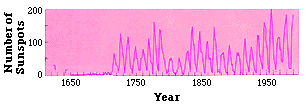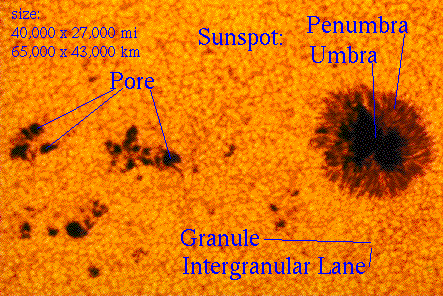![]()
The amount of magnetic flux that rises up to the Sun's surface varies with time in a cycle called the solar cycle. This cycle lasts 11 years on average. This cycle is sometimes referred to as the sunspot cycle. Near the minimum of the solar cycle, it is rare to see sunspots on the Sun, and the spots that do appear are very small and short-lived. During this "solar maximum", there will be sunspots visible on the Sun almost all the time (often there are more than 100 spots visible at a time!), and some of those spots will be very large (up to 50,000 km in diameter) and last several weeks. There was a sunspot maximum in 1989-1990 and we expect another one in 2000-2001.

Sunspots are regions where the solar magnetic field is very strong. In visible light, sunspots appear darker than their surroundings because they are a few thousand degrees cooler than their surroundings. Most of the visible surface of the Sun has a temperature of about 5400 degrees C, but in a big sunspot the temperature can drop to about 4000 degrees C. Sunspots come in sizes between about 2500 km and about 50,000 km. So while they are quite large, they are still much smaller than the Sun itself, which has a diameter of 1,392,000 km. Most sunspots are roughly circular in shape. Sunspots have two distinct parts: the umbra and the penumbra.

Sunspots do not appear everywhere on the Sun. They are usually concentrated in two bands, about 15 - 20 degrees wide in latitude, that go around the Sun on either side of the solar equator. The average latitude of those bands varies with the solar cycle. Just after the minimum of the solar cycle, sunspots appear at an average latitude of about 25 - 30 degrees (both north and south of the equator). As the solar cycle progresses, newer sunspots appear closer and closer to the equator. The last sunspots of the solar cycle appear at an average latitude of about 5 - 10 degrees. During all parts of the solar cycle, sunspots are almost never found at latitudes greater than about 70 degrees.
For more information about sunspots and the solar cycle, see:
How to Observe the Sun and SunspotsYou should never look directly at the Sun with the naked eye or through any instrument such as binoculars or a telescope. To observe sunspots, set up a small telescope and set the eyepiece a little farther out than you would in its normal viewing position. Good old fashioned trial and error will allow you to point the telescope at the Sun. Take a large card or piece of white paper and hold it about 6 to 8 inches beyond the end of the eyepiece. Look at the bright spot on the card and slowly move the card in and out toward the eyepiece until you obtain a nicely focussed image of the Sun. You may need to adjust the eyepiece location and as well as the distance to the card in order to get the best possible image. Take a piece of paper and draw the sunspots you see each day as they appear on the Sun. Doing this for several days or weeks will allow you to follow the spots as the move from east to west as the Sun rotates. |
![]()
The StarChild site is a service of the High Energy Astrophysics Science Archive Research Center (HEASARC), within the Astrophysics Science Division (ASD) at NASA/ GSFC.
StarChild Authors: The StarChild Team
StarChild Graphics & Music: Acknowledgments
StarChild Project Leader: Dr. Laura A.
Whitlock
Curator:
Responsible NASA Official: